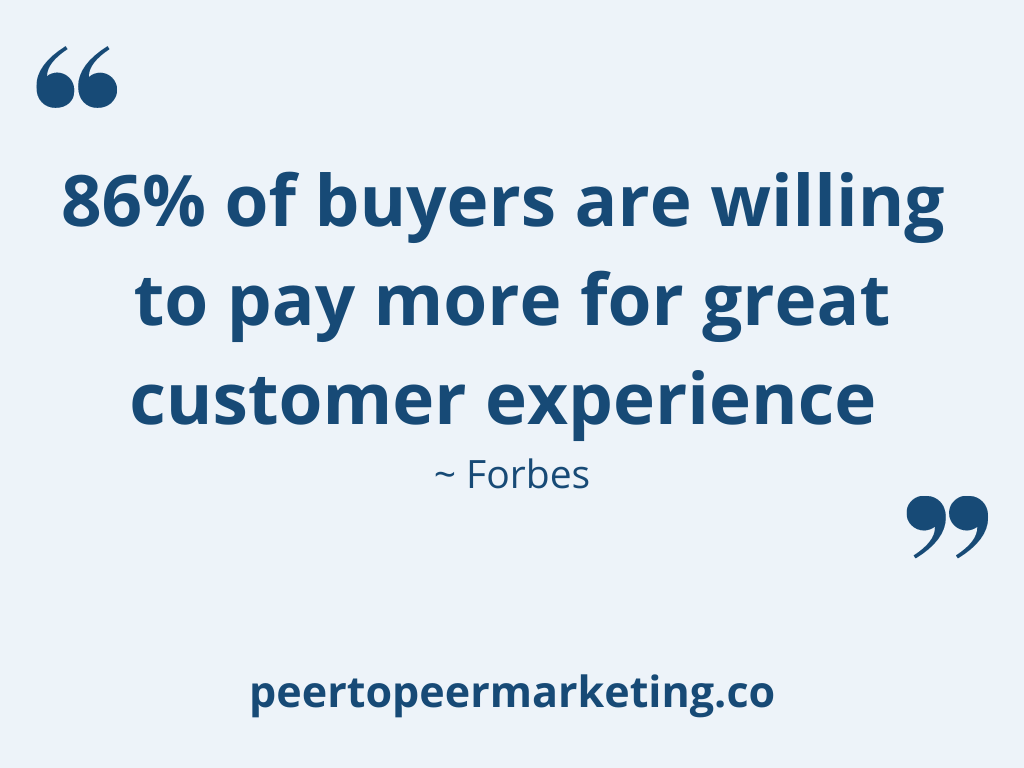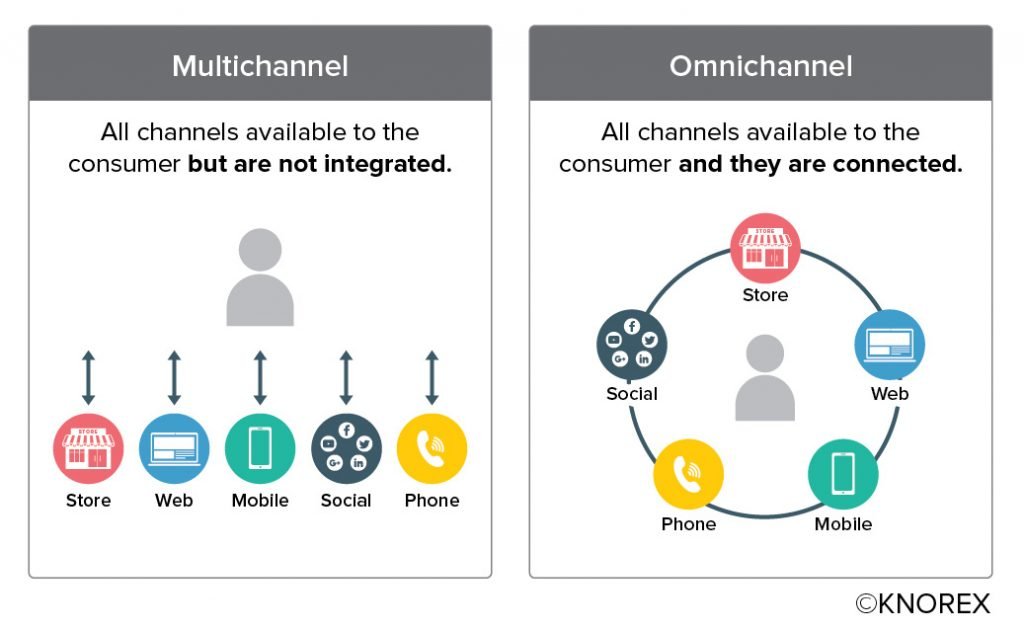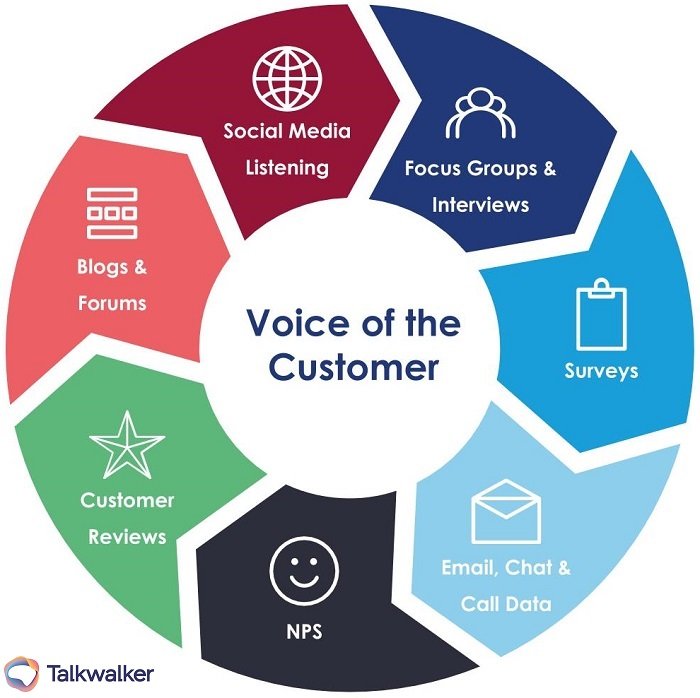A customer-centric strategy focuses on the needs of the customer and provides a great customer experience at every step of the customer journey.
In an online, global economy, the most important difference between you and your competitors is the level of customer satisfaction and delight you can provide.
In fact, as of 2024, more than two-thirds of companies now compete primarily on customer experience, which makes customer-centricity an essential concept and practice for successful brands.
This guide covers everything you need to know about developing and implementing a successful customer-centric strategy for your business.
We cover what customer-centric means for you and for your customers, the challenges and the benefits of taking a customer-focused approach, and a step-by-step guide to implementing a customer-centric strategy for your business.
Let’s jump right in!
In the simplest terms, customer-centricity means putting the customer front and center in the way you do business.
A customer-centric organization focuses on the customer’s needs, preferences, and values to provide an outstanding customer experience.
In the US, enterprises lose an estimated $83 Billion per year due to poor customer experience that leads to defection and abandoned purchases.
At the core of customer-centricity is listening to your customers, understanding them and what they want.
This means actively soliciting customer feedback, and then acting on that feedback to continually improve their experience.

Achieving customer satisfaction and loyalty is the best way to guarantee long-term growth and success for your business.
Developing lasting relationships with your customers secures higher customer lifetime values (CLVs).
It also leads to greater brand advocacy, which is an essential component of success in a digital world, and reduces customer acquisition cost (CAC).
Acquiring and retaining customers is at the heart of all businesses. Whenever a customer-centric organization makes a decision, that decision considers the customer and their experience.
In this way, they’re able to develop products and services that best meet their customers’ needs.
They can also deliver them in a manner that pleases and resonates with their customers. Forgetting or ignoring your customers is a sure path to failure.
Most, if not all, organizations recognize the importance of great customer service and support. However, many do not extend that beyond customer-facing departments to the whole organization.
To be successful in the long run, customer-centricity has to become part of your company culture and the DNA of your company.
Customers dealing with a customer-centric organization feel seen and appreciated. Their needs, wants, and preferences are met.
This means they’re getting the products/services they want delivered in the best way possible.
Their priorities and values are met, as well as their needs.
From their first interaction to their last, they’re receiving value and having a positive experience. Every touchpoint, every point of contact, is a good experience.
No matter how great your product or service is, a less than enjoyable customer experience will lose you that customer – along with every customer they would have referred to you in the future!
Adopting customer-centricity and building a customer-centric culture is the key to:
Shifting to a customer-centric culture seems relatively simple but it is a profound change that affects every aspect of your organization.
Some of the common challenges organizations face on the path to customer-centricity can be detrimental to the success and sustainability of the program.
Being aware of these challenges, and mindful of them when you’re planning and implementing your customer-centric strategy, will help you overcome them or avoid them altogether.
So, if you’re just starting or you’re already on your way but seeing some unexpected bumps in the road, there are some of the things to look out for:
Leaders set the tone in any organization. It is imperative for leaders to walk-the-talk when it comes to developing a customer-centric culture.
Successful customer-centricity is a permanent change in the way an organization does things. It is not a program or short-term strategy.
Leaders often revert to old ways of doing things after a while, especially when they don’t see immediate results and need to meet their targets.
When leaders don’t fully embrace the change, they’re setting an example for those in their charge.
Keeping leaders engaged and motivated for customer-centricity is key to successful and long-lasting change. As decision-makers, they need to be on board in a meaningful way. They need to walk-the-talk for others to follow.
Successful customer-centricity is practical and speaks to the day-to-day operations of the organization.
Many organizations fail when their strategy is at odds with the function employees need to fulfill in their jobs.
Asking employees to consider the customer in their role at the organization is futile if they’re not given practical ways to do so.
A strategy will remain a purely theoretical endeavor if employees are not able to understand and implement it, as it pertains to their role.
This comes down to planning and overseeing the implementation of the strategy. And amending it as and when needed, to ensure that it is practical and efficient.
This applies to project prioritization, budgeting, and an overarching view of the organization as well.
A strategy that doesn’t mesh with the interrelated operations of the organization as a whole, is destined to be abandoned when things don’t go according to plan.
Many organizations fail at viewing customer experience in a global sense, with an overall objective for the company as a whole. Reframing operations to better serve a positive customer experience needs to be a collaboration between all departments.
When one department changes the way they do things, even slightly, there can be cross-department ramifications that may lead to frustration, conflict, and a loss of efficiency overall.
For long-term success, different departments need to understand the overall goal and how the other departments are working to support it, as well as their own.
A client-centric strategy is doomed to fail if there is not enough contact and communication between the organization and its customers.
Most companies will put in place means for customers to give feedback through ratings and surveys but many neglect to set up and maintain points of personal, real-time, detailed contact.
A telephone conversation or undirected text chat with your customer will give you a much more detailed picture of their experience than a satisfaction rating or fixed checkboxes on a survey.
Voice of the Customer (VoC) is an essential component, which too many companies do not use to the fullest.
It is essential to give customers a way to communicate their experience in their own words, and ways to volunteer constructive feedback. They will feel heard, important, and considered in the process too.
Customer service and marketing departments generally know an organization’s customers best.
They have access to insights, feedback, and contact that those developing products rarely have.
Product development, especially in SaaS, may focus too heavily on the product and not enough on the customer’s experience.
Bi-directional communication between product development and the rest of the organization is essential in a product development lifecycle.
The best product in the world will not delight your customers if it doesn’t speak to their most subtle needs, values and preferences.
The same goes for customer service – supremely helpful and efficient email support will not delight customers who want to talk to a ‘real person’ on the telephone.
Monitoring your progress and level of success when you’re implementing your strategy is essential.
This is how you determine if you’re on the right track or if things need to be adapted for better results.
However, many companies struggle to get the right balance between the success of the strategy and the success of the organization’s internal processes, as they have been traditionally measured.
When internal Key Performance Indicators (KPIs) do not align with your customer-centric strategy, they drive the wrong behaviors.
Successful customer-centric organizations assess cross-functional performance by linking critical internal KPIs with Voice of the Customer (VoC) to demonstrate the correlation and progress towards targets.
A common misconception about customer-centricity is that is a soft benefit, a ‘warm fuzzy’ nice-to-have, or that is a fancy marketing term for ‘great customer service’.
This could not be more wrong!
Insights into the importance of customer experience show that it has a direct, measurable, impact on business success and revenue.
According to the Temkin Group, companies with annual revenue of $1 billion can expect an average increase of $700 million over three years when they invest in customer experience.
This figure jumps to an increase in revenue by $1 billion for SaaS companies.

These increases in revenue are coming from increased purchase values, longer customer relationships, and increased customer lifetime value.
According to Forbes, 86% of buyers are willing to pay more for a great customer experience and research from PwC shows that 32% of customers will walk away from a brand they love after a single bad experience.
Customer experience also has a profound impact on impulse purchases, which 49% of buyers stating that they had made an impulse purchase after receiving a more personalized experience.
With numbers like these, it’s easy to see that customer-centricity pays! But how is it doing that and why?
Let’s look at six of the (many) ways a customer centric-strategy impacts your business, to drive increased revenue:
One of the most important and measurable benefits of customer-centricity is improved customer retention.
Focusing on continually improving customer experience, throughout the customer’s journey with the company, and re-engaging customers leads to greater customer satisfaction and fosters customer loyalty.
Three critical metrics for success are your Customer Satisfaction Score (CSAT), Net Promoter Score (NPS), and Customer Effort Score (CES).
These metrics allow you to measure your overall customer experience. Many companies already use these metrics, even if they have not yet adopted a fully customer-centric approach.
Customer-centric organizations score higher on all three scores.
Social proof in the form of recommendations, referrals, reviews testimonials, and positive user-generated content is a huge driver of trust, credibility, and brand recognition.
Satisfied customers generate valuable social proof, which attracts new customers. Satisfied customers are also more likely to recommend your business to others and participate in referral programs.
Customers acquired through referrals, social proof, and word-of-mouth marketing cost companies a fraction of customers acquired by other means.
When customers are satisfied, they stay with a company for longer, make more repeat purchases and spend more on each purchase. This leads to an increased CLV.
In addition, it is more cost-effective to retain customers than it is to acquire new ones so investing in customer experience and retention is vital.
Tracking customer satisfaction and actively listening to customer feedback gives an organization the ability to develop better products and services.
This kind of data is difficult to obtain from general market research as it pertains to your specific audience – the customers who already buy from you.
These factors combine to drive an increase in sales revenue and a reduction in sales costs.
The result is that companies that focus on providing a great customer experience are more profitable.
They’re also more sustainable and more likely to weather adversity.
Amazon withstood the recession in the 1990s by using a customer-centric approach that gave people what they wanted and needed, within the context of their immediate economic climate.
They gave them exactly what they needed, right then, and when the economic climate shifted, they shifted with it to keep giving their customers a contextually relevant experience.
That is something only a truly customer-centric organization can achieve.
In 2021, we faced with the ramifications of the Covid-19 pandemic and its economic impacts, which will be felt for years to come.
According to Forbes, in their piece on the Summit 2020: Lessons In Resilience And Customer Centricity, shifting to customer-centricity and focusing on customers’ needs is key to navigating the future.
Companies that better understand and are more responsive to their customers’ needs can make more agile, nimble, and impactful changes to shore up profitability.
To formulate and implement a successful customer-centric strategy, you need to create a way forward that allows you to gather meaningful information about your customers and address their needs along every step of the customer journey.
Every organization’s strategy will look a little different. Different company sizes, industries, locations, markets, and means of delivery will all impact the finer details of your strategy.
With that said, here are the key steps to take:
Start at the top of the organization and make sure that your leaders are on board. When leaders make customer-centricity a priority, it sets the tone and sets an example for everyone else.
For this to be truly effective, leaders must understand the value of customer-centricity. They must understand how it involves each and every aspect of your business.
Leaders should be equipped with the knowledge and tools to implement, measure and track the strategy, in a meaningful way.
For leaders to walk the talk, they need to value the concept and understand how it will work for them. They also need to know how it will benefit them and their internal KPIs.
It is also important that leaders are given autonomy in how the strategy is implemented. This will encourage ownership and engagement.
When leaders are personally invested in the success of the strategy, they’re more likely to run with it and make it a success. Buy-in from leadership is also essential for developing a truly-customer centric culture in your organization.
To be successful, your customer-centric strategy needs to be a permanent change, rather than a short-term plan.
Developing a strong, customer-centric, company culture is the key to making your strategy more than a ‘program’ and part of the company’s DNA.
In most customer-centric organizations, company culture is the foundation of their success. It starts with making sure that everyone understands the concept and what the customer really wants.
This applies to everyone, not just frontline workers, and key decision-makers in particular.
Some ways to achieve this include regularly sharing customer personas, data insights, trends, and customer feedback.
It is also a good idea for everyone to be part of direct customer service in some way. When they’re helping customers, they get a sense of how it feels to be solving a customer’s problem.
Ownership and autonomy are also important aspects. Consider empowering your employees to make decisions on their own when dealing with customers and give them the ability to personally do things to delight your customers.
This approach has been used very successfully by Zappos. The retailer is one of the most successful and prominently customer-centric companies, along with the likes of Amazon.

Another thing to consider is how new employees will fit into your customer-centric company culture.
Hire people who fit and who will further your strategy with enthusiasm.
Make it a part of your onboarding process and set the tone with them right from the beginning.
This will help you build an organization that leans into providing great customer experience with enthusiasm.
This cannot be overstated – make sure that your strategy is practicably applicable and actionable!
A successful and long-lasting strategy is one that can be effectively translated into measurable actions and outcomes.
Changes must be well thought out, taking into consideration cross-function ramifications. What one department does differently may necessitate a change in another and so on.
For it to be effective, the strategy must take these changes into account and minimize friction between departments.
Everyone must understand them and how they apply to them, as individuals carrying out their role in the company.
If your employees can’t understand how to make your strategy work, they will revert to the old way of doing things. The same applies to strategies that cause friction between departments.
Giving everyone in the company a global view of how they’re working together creates an awareness and understanding that will foster collaboration.
Frequent, meaningful communication with customers is essential for a great customer experience and at the heart of any successful customer-centric strategy.
Voice of the Customer (VoC) solutions will help you do this, as will integrated omnichannel support and contact.
Our online, digital, world offers a host of ways to talk to your customers and as many ways to collect useful data from those interactions.
Every department should be using these channels and insights to guide them as they support the development of a great customer experience.
These channels need to be seamlessly integrated and connected.

Another important aspect is how accessible you are to your customers.
Customers want to be able to interact with your company in a variety of ways so they can choose the option that suits them best.
Telephone, email, instant chat, social media – every client will have a preferred means of communication.
You must be available on that platform for them. Be easily accessible, using the customer’s preferred method of communication.
Listening to your customers, taking what they have to say, and doing something meaningful with it is the key to success. It builds relationships and fosters trust.
Use all the tools at your disposal to generate accurate, detailed, customer personas.
This will help you appropriately segment and target your customers, to give them the best experience for their needs.
Customer-centric segmentation is geared towards customer retention and satisfaction, rather than customer acquisition.
Investing in customer research and appropriate segmentation will enable you to focus on where it is most profitable. It also ensures that your customers are getting what they value the most from you.
Gathering qualitative feedback will help you understand your customers and how you can best solve their problems and delight them.

One way to gather this data by conducting a Voice of Customer survey. There are many different tools, like SurveyMonkey, that you can use to do this.
They use data from pop-ups on your website or emails to gather precise information on the expectations and attributions of your customers.
Other options include social events hosted by your company, webinars, and workshops. Events like these allow you to interact with your customers and learn more about them.
Open-ended, real-time, communication often reveals more nuanced and useful insights.
Social media is another hugely important source of information.
Comments and mentions are left spontaneously by customers who wish to express something to you (or about you) and reveal a great deal about their experience with you.
Digital solutions can help you track spaces like Facebook, Twitter, Yelp, and Reddit.
Quora is another great source of information. The questions asked and answered on the platform give insight into the issues where customers are turning to sources other than your company for answers.
The more you can listen and observe your customers, the better equipped you will be to anticipate their needs and solve their problems.
Developing products and services that meet your customers’ needs and desires is critical to customer-centricity.
Product/service development must be in the loop on customer feedback.
The beauty of customer-centricity is that it continually allows you to see how your solutions can be improved.
Inadequate communication between those gathering feedback and those developing products will limit your efforts in both directions. Product development and customer experience will both suffer.
That said, product/service development should not be limited to reactively trying to please customers.
Proactive approaches that anticipate needs ahead of time are hugely valuable.
By paying attention to industry trends, advances in technology, and new possibilities for innovation, you can also anticipate what customers will need in the future.
Measuring and tracking your strategy involves tracking key metrics.
Measure customer experience, return on investment, customer lifetime value, and your own internal KPIs.
It is important to remember that internal KPIs need to be correlated to your strategy.
This allows you to see how they impact each other and the value your strategy is adding or detracting from your internal KPIs. This will allow you to adapt and re-evaluate as you go, to maximize the benefits.
Internal KPIs will be unique to your business but the key metrics to measure to track your customer-centric strategy are:
These metrics make up your Voice of Customer Sore (VoC). They also give you additional insights into how well your customer-centric program is working and the tangible results.
They also allow you to calculate your return on investment (ROI), which is important to track too.
The insights from these metrics will inform how you evolve and adapt your strategy over time, to continually improve and increase its value to your business.
Customer-centricity is an on-going endeavor. Continually tracking and adapting your strategy to keep evolving with your customers is the key to long-term success.
To wrap it up, we have covered the definition of customer-centric marketing, the benefits of customer-centricity, and the challenges commonly faced when implementing the shift to become a customer-centric organization.
We have also gone over the key steps to incorporate into your, unique, customer-centric strategy and how to measure and track your progress.
This guide gives you everything you need to start your customer-centric strategy today!
Forbes: Summit 2020: Lessons In Resilience And Customer Centricity
Forbes: 4 Actionable Customer Experience Statistics For 2020
HubSpot: 8 Tips for Becoming a Customer-Centric Organization
HubSpot: 3 Common Barriers to Customer Centricity
KPMG: Customer Metric: Sideshow or Game Changer?
PwC: Experience is Everything: Here’s How to Get it Right
Qualtrics: What is Voice of the Customer (VoC)?
Qualtrics: How to Create a Customer Experience (CX) Culture in Your Organisation
SuperOffice:37 Customer Experience Statistics You Need to Know
Customer-centricity is a way of doing business that focuses on the needs of the customer and providing a great customer experience. It differs from customer service in that it involves the entire organization and not just frontline/customer-facing departments. Read the full guide for more information on the meaning of customer-centricity, how to adopt it on your organization.
There are many, interrelated, benefits to using a customer-centric marketing strategy and becoming a customer-centric organization. These include:
- Reduced Churn Rates/Increased Customer Retention Rates
- Improved Customer Satisfaction Metric Scores
- Increased Social Proof, Brand Advocacy, and Referrals
- Reduced Customer Acquisition Costs
- Higher Customer Lifetime Value (CLV)
- Access to Valuable Data for Product Development
- Increased organizational agility and resilience
Read the full article for more on the benefits of customer-centricity and how it can help your organization.
Common challenges encountered when implementing a customer-centric strategy include:
- Lack of Meaningful Buy-in from Leadership
- Impractical or Overly Theoretical Customer-centric Strategies
- Lack of a Global Approach to Prioritizing Customer Experience
- Insufficient Customer Contact and Feedback
- Lack of Communication Between Customer Service and Product Development
- Measuring the Wrong Metrics to Assess Progress and Success
Read the full guide for more on the challenges of customer-centricity and how to overcome them.
Customer-centricity means putting the customer front and center. A customer-centric organization focuses on the customer’s needs, preferences, and values to provide an outstanding customer experience. Read the full guide for more on the customer-centric definition, and how to adopt customer-centric marketing.